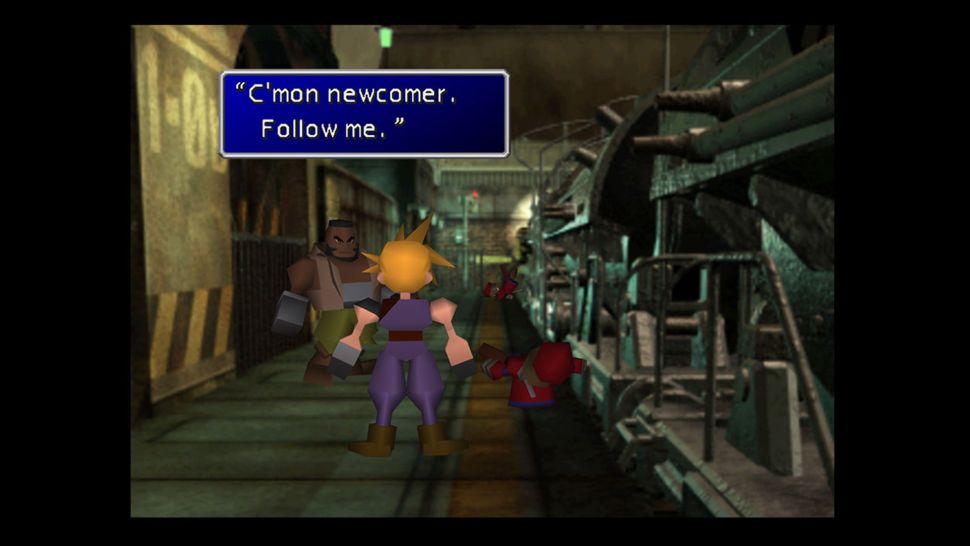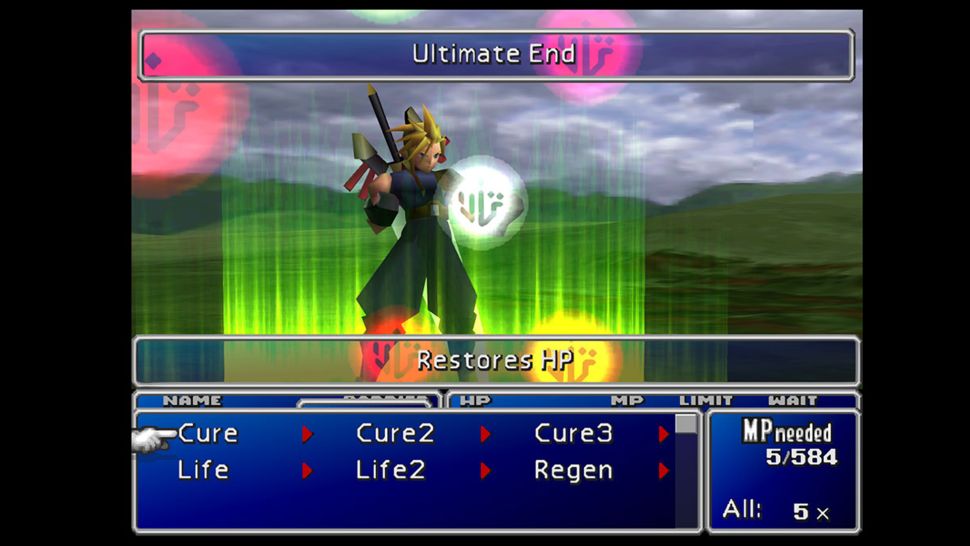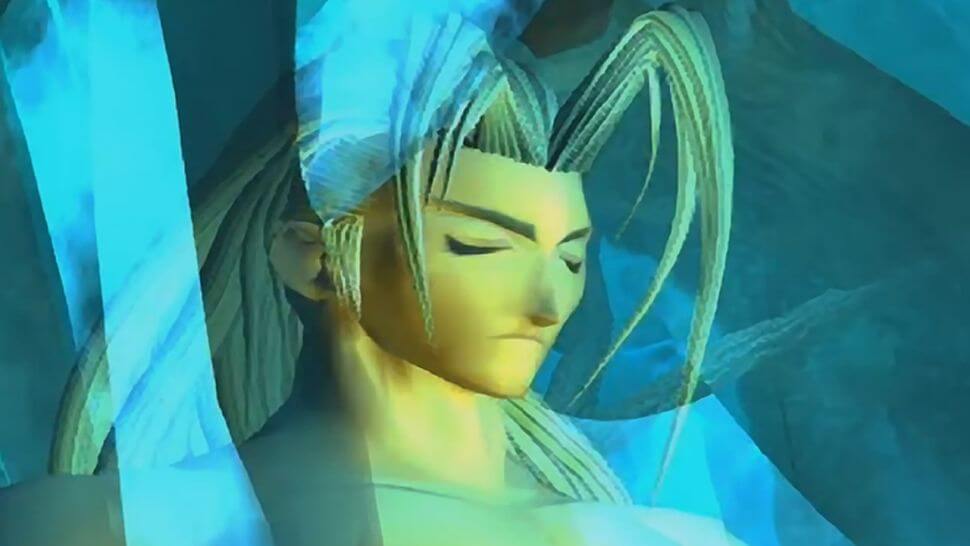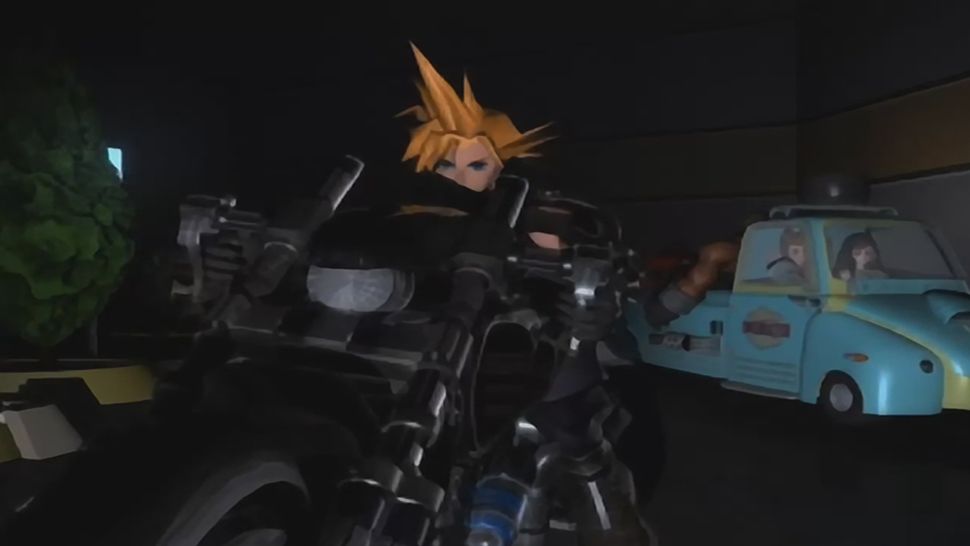Final Fantasy 7 – how Square made one of the most important and influential RPGs of all time
Director Yoshinori Kitase and art director Yusuke Naora reflect on the creation of Final Fantasy 7

(Image credit: Square Enix)
Final Fantasy 7 was an enormously influential RPG that introduced a lot of players to the genre. While the series had released in America previously, this was a breakout success, selling over 10 million copies and marking the first time the series was available in Europe. The way it used the capabilities of CD-ROM helped sell the PlayStation, and it made the subsequent release of each Final Fantasy entry into a real event. It’s also divisive, in some ways, anecdotally referred to as the most returned game of all time and often criticised by fans of RPGs that hand players more control over the story and characters.
Along with Gran Turismo, Final Fantasy 7 shifted millions of PlayStation consoles by demonstrating the machine’s capabilities. Its character designs would shape Japanese RPGs for years to come – and the key moments from its story are discussed to this day.
Final Fantasy 7 makes its debut
At the 1995 SIGGRAPH CG convention in Los Angeles, Square presented an interactive demo to the world that showcased Final Fantasy in unprecedented fashion. This depicted three characters from Final Fantasy 6 fighting a Golem enemy in full 3D, a clear break from the SNES-based 2D pixel art, complete with visual effects and cinematic in-battle camera angles that showed a glimpse of how the publisher saw the series evolving. When you look at the tech demo now, you can absolutely see the presentation of final Fantasy 7’s battles within.
The SIGGRAPH project would form the ‘seed’, as producer and creator Hironobu Sakaguchi dubbed it on a promotional video for the game, of Final Fantasy’s move into the next console generation. To anyone paying attention to industry news at the time, the most well-known part of the early development of Final Fantasy 7 is the defection to Sony’s new PlayStation hardware.
Square shifted to the PlayStation for its CD-ROM capabilities over the N64’s comparatively limited cartridges. This fit the team’s technological ambitions for this new entry. “We were fans of Nintendo’s hardware, although in order to use CG movies in the game like we intended, we needed a lot of storage space, and for that reason decided on a platform that used the higher-capacity CD media,” director Yoshinori Kitase says in an email interview.
An interesting factor in all this was the set of technical influences on the team, many of which were from Western game development, as Kitase explains: “We looked at trends in the foreign-made PC games of the time, such as Alone in the Dark and Heart of Darkness [and so on], and made it our objective to combine together smooth action sequences using polygon-based characters and clever camera work with the insertion of effective CG movies at a high level. I believe that we pretty much achieved our goals in this regard.”

(Image credit: Square Enix)
When it came to setting, Final Fantasy 7 would also represent a big change. While Final Fantasy 6 had pronounced steampunk elements, the set of environments in the seventh game would vary massively from continent to continent, from a vast, polluted metropolis to a sunny beach town, to tiny villages. Midgar is so different to the other locations players encounter in the game—there’s the presence of a grim modern world clashing against more picturesque remnants of an old one. It’s incongruous in a fascinating way.
I asked Kitase to discuss the inspirations for how this broad setting came to life, and he graciously passed my questions on to Final Fantasy 7’s art director, Yusuke Naora. “Initially we wanted to try something new by having a corporation as the major enemy while still keeping the game broadly in the fantasy genre,” he explains, referring to the Shinra Electric Power Company, the game’s other antagonists, aside from Sephiroth. “Having decided on this concept, we actively included many steampunk-like elements to try to merge the appeal of traditional high-fantasy ‘brick-built’ structures and sci-fi elements at a high level. However, as there was to be magic present in this world, it would have been hard to have cyberpunk-esque unknown future technology sitting comfortably with the other influences, so we tried to keep that aspect down as much as possible.”
Naora continues: “On the design side, we were also very much inspired to mix in things from many different periods in a semi-chaotic manner, including things from our everyday lives such as the newer buildings in Tokyo, the streets of Ginza, and the Shibuya station building.”
It’s the struggle between Cloud and Sephiroth that players remember about the story in Final Fantasy 7—both in the patchy flashbacks to the Nibelheim Incident, and their ultimate, long-awaited confrontation. “Throughout the story I really wanted to depict Sephiroth as an overwhelmingly powerful threat. However, if you have a villain as an actual opponent who appears before the heroes then however strong or charismatic you make the character, he will still feel very much ‘life-sized’ and limited in scope, reduced to another minor evil.”
Why doesn’t Sephiroth appear all that much in Final Fantasy 7’s story? The influence behind that might surprise you. Kitase continues: “To solve this problem, I decided to present Sephiroth indirectly, making the player aware of his existence through hints and stories but not having him show himself before them much. The player sees the aftermath of his ruthless deeds but does not arrive at the source of the evil for a long time. This was the same method used by Steven Spielberg in the film Jaws. Finding the butchered President Shinra on the top floor of the Shinra building and the impaled body of the Midgar Zolom are moments symbolic of this approach.”
Players don’t properly encounter Sephiroth until they’re around ten hours in, and even then it’s in fleeting glimpses, or in other forms. Cloud’s own muddled memories and tragic backstory mean the two end up being weirdly symbiotic. “Furthermore, however far the player pursues him, Sephiroth is always just out of reach, and because of this our image of him becomes more and more idolised and idealised,” explains Kitase. “This story structure also overlaps with the reasons that Cloud has such a complex about his own past, and I believe it is an effective tool for showing the relationship between the two characters.”

(Image credit: Square Enix)
This was the first project where Tetsuya Nomura would be the sole character designer, who, having contributed work to Final Fantasy 5 and 6, replaced Yoshitaka Amano from the previous titles. A Famitsu interview with Nomura (translated by Andriasang) explains that Cloud was essentially his creation, and Kitase told us that determining both the looks and personalities of each one of Final Fantasy 7’s cast of characters was “largely the responsibility of [Nomura]”.
It marked a sea change for the series. Amano’s art was dreamy, strange and incredibly striking, and Final Fantasy was mostly set in medieval-style worlds up until Final Fantasy 7’s release. Nomura’s designs would have a marked impact on popular culture—Cloud’s combination of spiky hair and a giant sword became almost shorthand for describing a not-very-original character design in later Japanese RPGs. Amano would still contribute character sketches and the iconic meteor logo.
The immense back story for these heroes and villains was fine-tuned by scenario writer Kazushige Nojima, while many of the actual narrative ideas came from a unique exercise at Squaresoft. “When designing the game, we asked all staff on the Final Fantasy team to submit possible episode ideas for character back stories and created the overall stories by putting these together,” says Kitase. “It was the scenario writer, Mr Nojima, who managed to put together a complete and detailed story from this massive pool of ideas, a process that was much like putting together a jigsaw puzzle.”

(Image credit: Square Enix)
“I decided to present Sephiroth indirectly, making the player aware of his existence through hints and stories”–Yoshinori Kitase, director
This exercise led to an intriguing collection of stories across the cast of heroes, with one main plot driving it all: the planet’s impending destruction at the hands of Sephiroth, where he would harness the world’s natural defences – known as the Lifestream – for himself. The cast of Final Fantasy 7 is a bizarre, varied crew, even by the series’ standards: you’ve got down-and-out pilot Cid, last of an ancient race Aerith, a puppet controller by a Shinra employee in Cait Sith, and Vincent, who you meet in a crypt and who can transform into monsters. Each has their own story to uncover, even if one character’s ends up being cut rather short.
With a corporation draining the planet of its resources and the game being made in the mid-’90s, you might wonder if environmental issues were a deliberate theme of the story. They weren’t exactly, as Kitase explains: “We did not particularly plan on bringing out environmental destruction as a major theme of the game but rather intended the story to depict the internal struggles of Cloud and Sephiroth.
“However, if pushed, I would say that this theme was not so much that of concern over destruction of the environment but more about how we wanted to show how civilisation and the environment coexist. Cloud and his companions first appear in the game as a group trying to take down the Mako reactors, but in the end we see them getting help from the Lifestream that is the source of that energy, and going forward into a future of coexistence with the planet. I believe that this theme of how we can strike a balance and live in harmony with the environment is one that is shared by all of us.”

(Image credit: Square Enix)
The Lifestream is the literal embodiment of the planet’s energy, where all life is created and where it returns to upon death. Its genesis came from Sakaguchi, who had come up with the idea as a reaction to tragic events in his own life. “When we were creating Final Fantasy 3, my mother passed away,” he said in a video to coincide with Final Fantasy 7’s release. “And ever since, I have been thinking about the theme of life. Life exists in many things, and I was curious about what would happen if I attempted to examine life in a mathematical and logical way; maybe this was my approach in overcoming the grief I was experiencing.”
Shinra, meanwhile, emerged as a deliberate response to previous antagonists in the series. “We had a feeling that ideas for villains in RPGs had kind of become stale and repetitive, with it always being something like a massive dragon or an evil ruler who had acquired an ancient power,” says Kitase. “When we asked ourselves what a more modern take on a powerful evil would be, we came up with the idea of a corporation that pollutes the environment for excessive profit.”
The most shocking moment in this story, though, would be the death of a major character. One of the conditions of running our exclusive interview with Square Enix was that we wouldn’t reveal this character’s name – but you know which one we’re talking about. Everyone knows it. You might have spent hours training this character up before the event occurred. It didn’t matter. This character was wiped out of the story. This would be the defining moment of Final Fantasy 7.
It is odd that Square Enix declined to comment on the sequence, having done so in the past – even Kitase himself, back in 2003. It could be that the company is hoping new players discover Final Fantasy 7 through the PlayStation Store on PSP or PS3, or that something new involving the game is in the pipeline. Either way, that moment was designed by Square to create a sudden void in the player, to make them think they’d have acted differently were they to know it was coming.

(Image credit: Square Enix)
There are more surprises besides, though. A major plot point some way into the game sees the threat level raised significantly as giant creatures, a super-boss motif of the series known as Weapons, march into the overworld and heighten the drama of the closing act. They’re also incredibly hard to kill, in the case of the Ruby and Emerald Weapons. Kitase explains why the team opted to do this: “In all Final Fantasy games, we always put in very powerful monsters in the latter parts of the game to challenge dedicated players and to deepen the gameplay experience, enhancing the longevity of the title and giving something to do aside from the main quest. We had already got the concept of the Weapons as defenders of the planet for FF7 and so decided to tie that together with these play-enhancing features.”
I ask Kitase about the Final Fantasy 7 team’s dynamic at the time, and how that affected development of the game. “Before FF7 we only really had 2D pixel art designers, but for this project many 3D CG specialists and designers came in from outside the company, leading to an interaction of various working cultures that was very stimulating,” he says. “All the in-house designers also started to learn to use CG tools, and we held a lot of seminars and explanation meetings. I personally received instruction in how to use Alias PowerAnimator, and around a tenth of all the character motions seen in the game’s event scenes were actually created by me!”
I had to ask Kitase if anything major changed in development – and, as it happens, Squaresoft seemingly had a strong vision of what Final Fantasy 7 was, with only one change that fans will definitely have noticed. “The only thing that we had to change during development was the level of deformation on the characters. The fact that the characters are depicted at different levels of deformation in the field, battle and CG sections is a remnant of these changes.” Whereas field characters ended up being blocky 3D models, the characters in battle had far more detail. As Kitase mentions, too, you can see this difference in CG movies – some depict the characters in blocky form, while others, like Sephiroth before the flames of Nibelheim, are more impressively realised.
The locations have really well in the PSone-era Final Fantasy games, thanks to the heavy use of pre-rendered backgrounds. Yet part of Final Fantasy 7’s appeal to long-time fans was the introduction of a fully 3D world map. Despite the cinematic touches present in other parts of the experience, the world map was seen as an updated version of the SNES overworld. “This part of the game was not actually all that much of a challenge,” says Kitase. “It goes without saying that, at the time, creating data for a 3D map was hard work, but for better or worse we decided to do the map along pretty similar lines to a 2D world map from the Final Fantasy games of the Super Famicom era, so there were not a lot of problems with the overall vision.”
Instead, the team had to spend more time worrying about the individual locations themselves, which were significantly more detailed with the generational leap. “It was actually a lot harder and took much more work realising the fully rendered backdrops for the towns and dungeons, as nothing like these had ever been done before at the time. Having said this, the world map in Final Fantasy 7 did play a very important role in the game. After the first part, which is spent in the oppressive and cramped environment of Midgar, the feeling of liberation and freedom at the moment when you step out onto the world map is one of the game’s most memorable highlights.”
Random battles would remain part of the series, but as directed by the SIGGRAPH presentation, the actual look of them marked an exciting leap between generations. “We had decided on the idea of battles in 3D, with the camera panning and zooming around the action, from before beginning development on Final Fantasy 7. In 1995, we created a prototype game based on doing the battles from FF6 in 3D and showcased it at the SIGGRAPH convention that year. This test game was made with an eye to perfecting the idea for the battles in Final Fantasy 7.” With the endlessly customisable Materia-based ability system as well as visually extravagant Limit Break attacks, combat is where Final Fantasy 7 really shined as an RPG.
Series composer Nobuo Uematsu returned for Final Fantasy 7, and he made for an easy collaborator. “We basically just showed Mr Uematsu the character designs and the scenario, and had him familiarise with the overall themes and images of the game before letting him loose. There were no specific detailed requests, and he was allowed to create the score comparatively freely,” says Kitase.

(Image credit: Square Enix)
There’s always been talk of a Final Fantasy 7 Remake, but players are setting themselves up for disappointment to an extent. Final Fantasy 7 was very much a product of the CD-ROM era, and everything was built on that foundation – bringing all of that back to life in the era of HD graphics would surely be a monumental challenge. We don’t have long to wait now to see just how true that is.
Still, the desire for Square Enix to revist the game is a testament to players’ attachment to this world, to these characters, and to the themes of identity, life and death that the story successfully explores. Final Fantasy 7 was so many players’ first step into the world of RPGs – that’s why it still has a special place in their hearts. On April 10, 2020, we’ll see whether the long-awaited Final Fantasy 7 Remake has been worth the wait, and whether this genre-classic can truly stand the test of time.
By Samuel Roberts, Retro Gamer Team

熱門頭條新聞
- The 2025 3D Creative Talent Showcase Competition is coming with a bang!
- Guangzhou Business College and Numerex Global Initiate Strategic Cooperation in Artificial Intelligence
- A Poster Reflecting the Festival’s Vibrancy and Passion!
- SAG-AFTRA Announces New Video Game Agreements for Students and Game Jams
- ZeniMax workers vote to strike over Microsoft negotiations
- The Shorts: The Heart of the Annecy Festival
- Lexar Ships the World’s First 1TB microSD Express Card
- Spellbinding magic life-sim Witchbrook is coming to PC, Nintendo Switch and Xbox this Winter
